推薦產品
化驗
≥98% (HPLC)
形狀
powder
顏色
white to beige
溶解度
DMSO: ≥5 mg/mL at warmed
儲存溫度
−20°C
SMILES 字串
[O-][N+](=O)c1ccc(OC(=O)N2CCN(CC2)Cc3cccc(Oc4ccccc4)c3)cc1
InChI
1S/C24H23N3O5/c28-24(32-22-11-9-20(10-12-22)27(29)30)26-15-13-25(14-16-26)18-19-5-4-8-23(17-19)31-21-6-2-1-3-7-21/h1-12,17H,13-16,18H2
InChI 密鑰
QNYRAEKLMNDRFY-UHFFFAOYSA-N
應用
JZL195 has been used:
- as a selective inhibitor of endocannabinoid (eCB) clearance enzymes to induce in vivo long-term depression at CA3-CA1 synapses and at prelimbic (PrL)-nucleus accumbens (NAc)synapses, to study the neuroprotective action of eCB
- to inhibit the action of hydrolytic enzymes that limit eCB activity, to study the effect of 2-linoleoylglycerol (2-LG) on the human CB1 receptor activity
- as a dual fatty acid amide hydrolase (FAAH)/monoacylglycerol lipase (MAGL) inhibitor to study its dose-related antipruritic effect on the serotonin (5-HT)-induced scratching model
生化/生理作用
JZL195 is a potent dual inhibitor of Monoacylglycerol lipase (MAGL) and fatty acid amide hydrolase (FAAH), enzymes that degrade the endocannabinoids 2-arachidonoylglycerol (2-AG) and anandamide (AEA), the endogenous ligands for the cannabinoid G-protein coupled receptors CB1 and CB2. IC50 values are 2 nM for MAGL and 4 nM for FAAH. JZL195 has been shown to inhibit endocannabinoid hydrolysis and elevate 2-AG and AEA levels in vivo.
儲存類別代碼
11 - Combustible Solids
水污染物質分類(WGK)
WGK 3
閃點(°F)
Not applicable
閃點(°C)
Not applicable
分析證明 (COA)
輸入產品批次/批號來搜索 分析證明 (COA)。在產品’s標籤上找到批次和批號,寫有 ‘Lot’或‘Batch’.。
Tania Muller et al.
American journal of physiology. Endocrinology and metabolism, 313(1), E26-E36 (2017-03-23)
Evidence has accumulated that obesity-related metabolic dysregulation is associated with overactivation of the endocannabinoid system (ECS), which involves cannabinoid receptor 1 (CB1R), in peripheral tissues, including adipose tissue (AT). The functional consequences of CB1R activation on AT metabolism remain unclear.
Ozgur Yesilyurt et al.
Archives of dermatological research, 308(5), 335-345 (2016-04-30)
The increase of endocannabinoid tonus by inhibiting fatty acid amide hydrolase (FAAH) or monoacylglycerol lipase (MAGL) represents a promising therapeutic approach in a variety of disease to overcome serious central side effects of exocannabinoids. Recent studies reported that systemic administration
Feng Wang et al.
Journal of cerebral blood flow and metabolism : official journal of the International Society of Cerebral Blood Flow and Metabolism, 39(6), 1122-1137 (2018-02-13)
Ischemia not only activates cell death pathways but also triggers endogenous protective mechanisms. However, it is largely unknown what is the essence of the endogenous neuroprotective mechanisms induced by preconditioning. In this study we demonstrated that systemic injection of JZL195
Shivani Jaiswal et al.
Biomedicine & pharmacotherapy = Biomedecine & pharmacotherapie, 107, 1611-1623 (2018-09-28)
Fatty acid amide hydrolase (FAAH) represents a potential therapeutic target for number of peripheral and nervous system related disorders including neuropathic pain and neuroinflammation. A library of N-(2,4-dichlorobenzoyl) isatin Schiff bases 7a-7l and 8a-8c were designed using the contemporary scaffold-hopping
Leanne Lu et al.
Cannabis and cannabinoid research, 4(4), 231-239 (2019-12-25)
Introduction: The cannabinoid type 1 (CB1) receptor and cannabinoid type 2 (CB2) receptor are widely expressed in the body and anandamide (AEA) and 2-arachidonoylglycerol (2-AG) are their best characterized endogenous ligands. The diacylglycerol lipases (diacylglycerol lipase alpha and diacylglycerol lipase
我們的科學家團隊在所有研究領域都有豐富的經驗,包括生命科學、材料科學、化學合成、色譜、分析等.
聯絡技術服務








